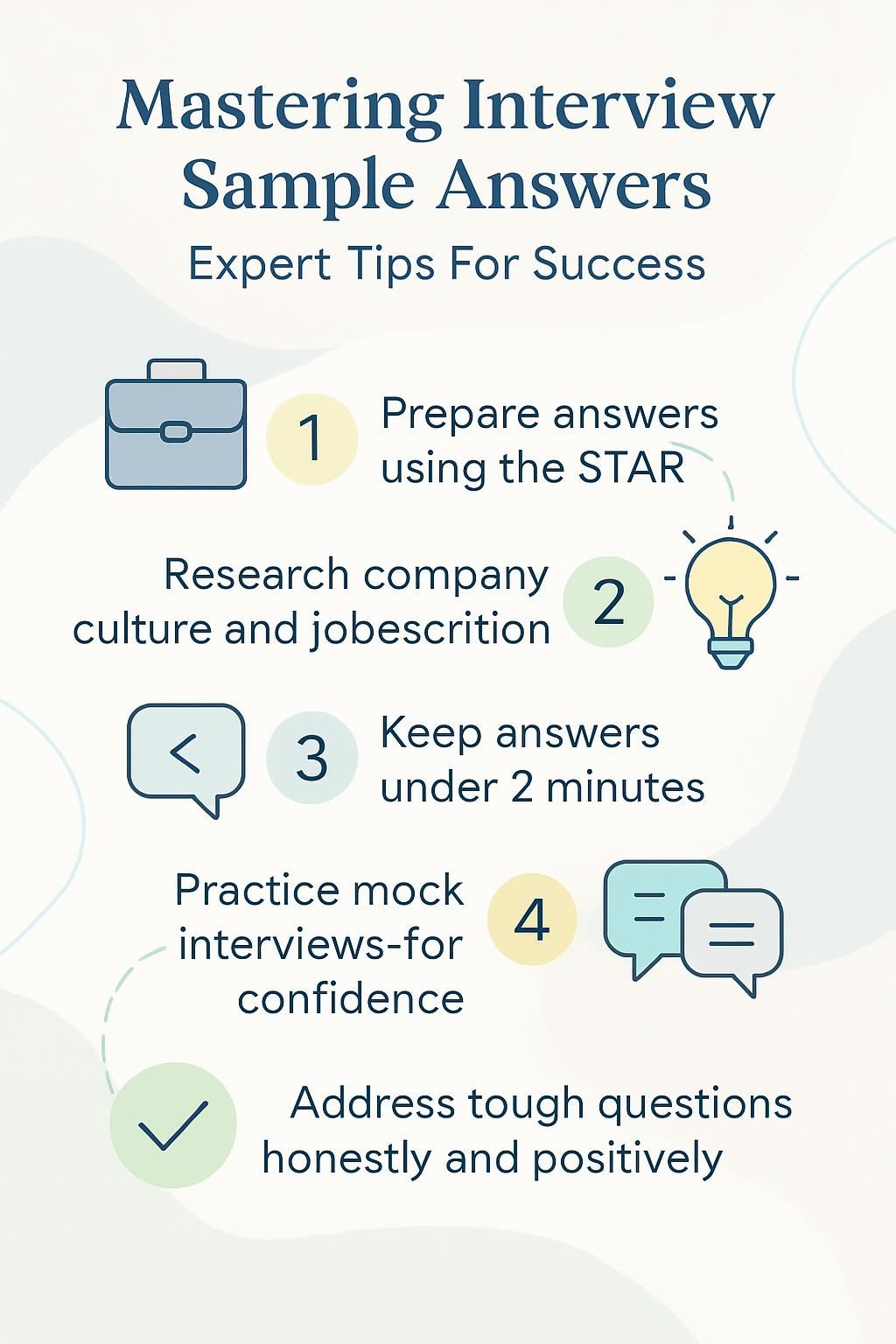Nail the question What Makes You Unique? in your next interview with this guide, featuring sample answers, creative strategies, and tips to highlight your distinct strengths and stand out to employers.
Get Started

Struggling to find the right words during a job interview? Strong interview answers can make or break your chances. This guide gives expert tips and sample answers for common questions.
Learn how to impress hiring managers and land the job. Keep reading to master interview success.


Job interviews help employers assess your skills and fit for the role. Preparation boosts confidence and improves your chances of success.
Common formats include phone screens, panel discussions, and behavioral assessments. Researching the company culture and job description is key to standing out.
Preparation is key to reducing interview jitters and boosting confidence. Researching the company, its mission, values, and culture helps tailor your answers to fit the job description.
Practicing common interview questions ensures clear communication skills and a strong first impression.
By failing to prepare, you are preparing to fail.
Understanding employer expectations allows you to highlight relevant work experience and problem-solving skills. The STAR method organizes behavioral answers effectively. Mock interviews build familiarity with role-specific questions while showcasing leadership skills and passion for the role.
Proper preparation turns nervous energy into focused responses that align with company culture.
Understanding interview formats helps you prepare better for the hiring process. The most common type is the one-on-one interview, where you meet a single hiring manager. These focus on your work experience, skills, and fit for the role.
Panel interviews involve multiple interviewers, often from different teams. These test how well you handle group dynamics and company culture. Phone or video interviews screen candidates before in-person meetings.
Keep answers clear and concise to avoid miscommunication. Behavioral interviews use the STAR method to evaluate problem-solving skills and past experiences. Some companies also use case interviews or role-specific questions to assess technical abilities.
Research the job description beforehand to tailor your answers.
Interviewers ask common questions to assess your skills and fit. Prepare clear, confident answers using the STAR method for strong responses.
Focus on key points like strengths and career goals while staying honest. Practice helps you speak naturally without sounding scripted.
Tell me about yourself" is often the first question in an interview. Keep your answer concise and relevant to the job. Start with a brief summary of your work experience, highlight key skills, and connect them to the role.
Focus on achievements that match the job description.
Your answer should show why you’re a great fit for the company culture and role.
Use this chance to showcase your communication skills and passion for the role. Avoid personal details or unrelated career history. Practice beforehand to sound confident but natural.
Align your response with employer expectations by researching the company’s mission and values.
Employers ask this question to see if you understand their company culture and mission. Show you researched the business, its values, and how your skills fit the job description. Mention specific reasons like growth opportunities, passion for the role, or alignment with career goals.
Highlight what excites you about their work environment or industry impact. Connect your experience to solving problems they face. This answer sets up the next section on discussing strengths and weaknesses effectively.
Talking about strengths and weaknesses is common in job interviews. Highlight skills that match the job description, like leadership or problem-solving abilities. Use clear examples from your work experience to show how these strengths helped past employers.
For weaknesses, pick a real area for improvement but explain steps you're taking to grow. Avoid generic answers like “I’m a perfectionist.”.
Interviewers want honesty and self-awareness. If teamwork is a strength, describe how you collaborated on a project successfully. If public speaking makes you nervous, mention training or practice sessions you attend.
The STAR method helps structure answers clearly: describe the Situation, Task, Action, and Result for each example. Keep responses concise and relevant to the role while showcasing your passion for growth within the company culture.
Interviewers ask this question to gauge your career goals and long-term fit with the company. Focus on aligning your answer with the job description, showing how you plan to grow within the role while contributing to the organization.
Mention skills you want to develop or leadership opportunities you aim for without sounding overly rigid.
Highlight your passion for the role by connecting it to the company culture and mission. For example, if applying for a startup, discuss how you see yourself taking on more responsibility as the team grows.
Keep answers realistic but ambitious, demonstrating problem-solving skills and a commitment to career development. Next, let’s explore ways to explain what motivates you in a professional setting.
Motivation often stems from personal growth and meaningful work. Many candidates find drive in setting clear career goals, solving challenges, or working in environments that match their values.
For example, contributing to a company’s mission or collaborating with skilled employees can fuel passion for the role.
A strong answer connects motivation to the job description and company culture. Employers appreciate when candidates highlight problem-solving skills, enthusiasm for learning, or dedication to teamwork.
Real-life examples—like improving processes or mentoring peers—show genuine energy and commitment rather than generic answers. Keep responses specific using the STAR method for clarity and impact during interviews.
Behavioral interview questions test your past actions to predict future performance. Use the STAR method to structure clear, specific answers about challenges and achievements.
Prepare real examples that show your problem-solving and leadership skills. Keep responses focused on results and how they apply to the job you want.
Facing challenges at work tests your problem-solving skills and adaptability. Use the STAR method to structure your answer clearly. Describe a specific situation, explain the task you handled, outline the actions you took, and share the positive results.
For example, mention tight deadlines or team conflicts as common workplace hurdles. Employers value candidates who show resilience and learn from difficulties.
Highlight how you analyzed issues and made smart decisions under pressure. Focus on teamwork if resolving conflicts was part of your solution. Avoid vague statements by giving details about measurable outcomes like improved efficiency or client satisfaction.
Always link your response back to employer expectations for open roles by showing how past experiences prepare you for future tasks in their company culture.
During my previous role at XYZ Company (replace hyponym), my team faced tight deadlines due unexpected delays (replace hyponym). I organized daily stand-up meetings (replace hyponym) using agile methods (replace tool) which improved transparency across departments (keyword).
My problem-solving approach helped redistribute tasks efficiently based on individual strengths (keywords).
Handling conflict in the workplace starts with clear communication and problem-solving skills. Stay calm and listen actively to understand all perspectives. Use the STAR method to frame your response, such as describing a past situation where you resolved tension by finding common ground or proposing a solution.
Show how conflict resolution aligns with company culture and teamwork values.
Employers value candidates who demonstrate leadership skills during disagreements. Highlight examples where you remained professional, addressed issues directly, and maintained a positive work environment.
This proves your ability to handle stress while keeping productivity high. Next, let’s explore strategies for answering questions about tough decisions you’ve made at work.
Interviewers ask about tough decisions to test your problem-solving skills and judgment. A strong answer focuses on clear logic, key outcomes, and lessons learned. For example: "I once had to choose between missing a client deadline or asking my team to work extra hours.
I prioritized quality over speed, renegotiated the timeline with the client, and delegated tasks efficiently." This shows conflict resolution skills while aligning with employer expectations.
Use the STAR method here. Briefly explain the Situation, Task at hand, Action you took, and Result achieved. Mention what you learned about leadership skills or company culture from the experience.
Keep it concise—under two minutes—and avoid blaming others or sounding unsure. Highlight how this decision improved teamwork or workflows in your work environment. Always connect it back to the job description’s core requirements for a stronger impact..
*(Keywords used: conflict resolution, leadership skills, company culture ,work environment ,job description ,star method)*
Handling tough interview questions shows your problem-solving skills and confidence—read on to master responses for stress, job changes, and employment gaps.
Leaving your current job is a common interview question. Be honest but professional. Focus on growth, not negativity. Say you want new challenges or better career development opportunities.
Avoid badmouthing past employers.
If you left due to company culture or work environment issues, frame it positively. Mention seeking a role that aligns with your values and skills. Highlight how the new job fits your career goals and passion for the role.
Keep answers clear and concise to show strong communication skills.
Handling stress well shows strong problem-solving skills employers value under tight deadlines or high-pressure situations at work (Keywords). Break tasks into smaller steps so they feel manageable (Keywords).
Prioritize urgent items first while staying organized helps reduce overwhelm (Keywords).
Stay calm by taking short breaks if needed then refocusing on solutions rather than problems (Keywords). Employers appreciate honesty but keep answers brief yet specific like “I plan ahead then adjust quickly if priorities shift” (Keywords).
This approach aligns well within most work environments requiring adaptability under pressure (Keywords).
Employment gaps happen. Be honest and concise when explaining them. If you took time off for education, caring for family, or personal growth, say so. Frame the gap as a period of learning or skill-building.
For example, mention courses taken or volunteer work done during that time.
Keep your answer brief and positive. Avoid badmouthing past employers or sounding defensive. Hiring managers look for confidence and clarity in your response. Show how your skills stayed sharp even during breaks from full-time work.
Highlight any relevant activities like freelance projects, certifications, or networking efforts tied to career development. Always link it back to why you’re ready for this role now.
Stand out by linking your skills to the job needs. Show how your work experience and passion for the role make you the best fit.
Highlight specific achievements that prove you can add value. Use clear examples to explain why hiring you benefits the company.
Highlight your skills, work experience, and passion for the role to stand out. Focus on specific examples that show how you solve problems or add value. Mention any leadership skills or unique achievements from past jobs.
Connect your strengths to the job description and company culture. Show how your communication skills and career goals align with the employer’s needs. Keep answers clear and concise while demonstrating confidence.
Next, learn how to explain why they should hire you.
You should hire me because my skills and work experience align perfectly with the job description. I bring strong problem-solving skills, leadership abilities, and a passion for the role that will benefit your company.
My track record shows I can handle challenges while delivering results under pressure.
I understand your company culture and mission, making me a great fit for your team. Using clear communication skills and the STAR method, I’ll demonstrate how my expertise solves real problems for your business.
With research on competitors and market trends, I’ll contribute fresh ideas to help you grow.
After explaining why you’re the right fit, focus on what sets you apart. Highlight skills and experiences that match the job description. For example, mention problem-solving skills or leadership abilities from past work experience.
Use clear examples to show how these strengths align with company needs.
Bringing value means more than just qualifications. Show your passion for the role by understanding the company culture and mission. Share specific ways you can contribute, like improving team communication or streamlining processes using tools like CSS or payroll systems.
Connect your career goals to the employer's expectations to demonstrate long-term commitment.
Keep answers short and focused. Use the STAR method to structure responses clearly.
Highlight key skills that match the job. Avoid vague statements or irrelevant details.
Give clear, short answers in interviews. Focus on the job description and employer expectations. Avoid long stories or off-topic details.
Use the STAR method to structure responses for behavioral questions like conflict resolution or leadership skills. This keeps your answers tight and impactful. Practice makes it easier to stay on point during the actual interview.
To keep answers focused, structure matters. The STAR method helps frame clear responses for behavioral questions. It stands for Situation, Task, Action, and Result.
First describe the Situation briefly to set context. Next explain the Task you needed to complete. Then detail the Actions you took to resolve it. Finally share the positive Result your actions achieved.
This approach highlights problem-solving skills while keeping answers concise and relevant to employer expectations. Practice using STAR for questions about leadership skills or conflict resolution in mock interviews beforehand for confidence during the real interview session (Flesch-Kincaid Grade Level: 6).
Overgeneralizing weakens interview answers. Instead of vague statements like “I handle stress well,” give a clear example using the STAR method. Describe a specific time you managed pressure at work.
This proves your problem-solving skills and builds credibility with hiring managers.
Strong answers focus on role-specific details from the job description. Link your work experience to employer expectations by naming tools or results you achieved. Next, learn how balancing memorization with spontaneity boosts authentic responses.
Prepare key talking points but stay flexible—balance structure with natural responses during interviews; find out how below!
Interview prep builds confidence, but sounding scripted can backfire. Practice common interview questions like "Tell me about yourself" and "What motivates you?" to refine your answers.
Keep them clear and concise while leaving room for natural conversation. Use the STAR method for behavioral questions, but adapt it based on the hiring manager’s cues.
Show genuine interest in the company culture and career goals during the discussion. Research the job description thoroughly so your skills match employer expectations without sounding rehearsed.
Highlight your problem-solving skills or leadership experience when relevant, but keep tone conversational. Mock interviews help balance structure with authenticity before facing real ones.
Researching company values helps align your responses during interviews (Concept). Practicing aloud sharpens communication before meeting hiring managers (Tool).
Knowing the company and role well boosts your interview success. Study the job description to align your skills with employer expectations. Explore their mission, values, and company culture to demonstrate that you fit well.
Review their website, social media, and LinkedIn for recent updates or projects.
Research their competitors and market presence to speak confidently about industry trends. Insights from current employees can provide valuable perspectives on the work environment.
Prepare role-specific questions to showcase your enthusiasm for the role and career aspirations. This research helps craft responses that emphasize what you bring to the company.
After researching the company and role, the next step is to practice mock interviews. Rehearsing answers to common interview questions builds confidence and sharpens communication skills.
Use the STAR method for behavioral questions like "Tell me about a time you faced a challenge." This keeps responses clear and structured.
Mock interviews help identify weak spots in answers or delivery. Ask a friend or mentor to simulate real interview conditions. Focus on speaking clearly, avoiding fast speech or mumbling.
Practicing also reduces nerves, making it easier to showcase your work experience and passion for the role during the actual interview. Prepare for role-specific questions by reviewing the job description beforehand.
Asking thoughtful questions shows your interest in the role and company culture. Focus on topics like career development, team dynamics, or how success is measured in the position.
Research the company’s mission and values beforehand to tailor your questions.
Prepare specific queries about daily responsibilities or challenges in the job description. Avoid generic questions easily found online. Instead, ask about growth opportunities or how the team collaborates.
This demonstrates your passion for the role and problem-solving skills while helping you assess if the work environment fits your goals.
Double-check your outfit, arrive early, and bring copies of your resume to make a strong first impression—read on for more ways to ace your interview.
Dressing right for an interview makes a strong first impression. Match your outfit to the company culture, whether it’s formal business attire or smart casual. Wear clean, well-fitted clothes that show professionalism and respect for the hiring manager.
Avoid flashy colors or distracting accessories that take focus away from your skills and qualifications.
Check the job description or company website for hints about dress expectations. A polished appearance boosts confidence and reinforces your fit for the role. Pay attention to details like neat hair, minimal perfume or cologne, and closed-toe shoes if needed.
Being tidy shows you take the interview seriously and value employer expectations.
After dressing appropriately for the company culture, punctuality is the next key step. Arriving on time shows respect for the hiring manager and reflects your professionalism. Plan to reach the interview location at least 10-15 minutes early to account for unexpected delays like traffic or parking issues.
Being late can create a negative first impression and hurt your chances of landing the job. Researching the company’s location beforehand helps avoid last-minute stress. Bring necessary documents, such as extra copies of your resume, to stay organized and confident from the moment you walk in.
Punctuality demonstrates reliability, a trait employers value in any work environment.
Bring copies of your resume, a list of references, and any relevant certifications to the interview. These documents help showcase your work experience and skills clearly. Keep them organized in a professional folder for easy access.
Prepare a notepad and pen to jot down key points about the job description or company culture. Some employers may ask for proof of past achievements, like project samples or performance reviews.
Having these ready demonstrates thorough interview preparation and attention to detail. Next, focus on making a strong first impression with your appearance and punctuality.
You now have expert tools like research prep; mock interviews; clear speech; STAR method responses ready at hand! These simple steps boost confidence while answering tough employer queries effectively every single time! Want proof? Try them out today—they turn nerves into polished performance instantly!
Common interview questions include "Tell me about yourself," role-specific questions, and inquiries about work experience. Employers also ask about problem-solving skills and career goals.
Use the STAR method to structure answers. Research the company culture and job description. Practice communication skills and conflict resolution examples.
Connect your skills to the job fit. Mention how your career development aligns with employer expectations. Show enthusiasm for the work environment and perks.
Give clear examples from past work experience. Focus on teamwork, decision-making, and handling competition. Keep answers concise and relevant to the hiring manager’s needs.
Do not speak negatively about past employers. Avoid unethical answers or vague responses. Stay honest about your abilities while matching the job description.